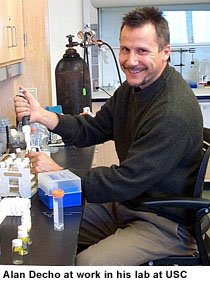|
Posted
12/12/2006
Biofilms, a new
frontier in microbiology, is the focus of scientists at the Decho
laboratory
 Life
on the cutting edge can be lonely. Life
on the cutting edge can be lonely.
Dr. Alan Decho remembers when he arrived at the University of South
Carolina12 years ago, eager to study something called biofilms.
"At the time it was not very well known. It fact, most of my grant
proposals were not funded because people didn't believe (biofilms)
existed," Decho said.
It's a different story today. Decho has research money and biofilm
research under way that reaches from his high-end lab at USC to the
tropical waters of the Bahamas.
Decho explained that while relatively new to scientific inquiry, biofilm
formation is a common microbial process that has been around about as
long as the earliest life forms on earth.
"We think of most bacteria as free cells just floating around," Decho
says from his fifth floor office in the Arnold School's new research
center.
A biofilm forms, he says, when bacteria attach to a surface and form a
slimy protective mucous layer. Behind the layer, the bacteria begin to
act as a single entity - much like an army -- using chemical signals to
direct their activities.
By organizing into a biofilm, a group of bacteria can become up to 1,000
times more resistant to antibiotics and able to resist chlorination,
radiation, high heat and other conditions that would destroy individual
cells.
THREATS TO HEALTH
Biofilms are all around as well as inside of us, says Decho. They are a
leading cause of hospital-acquired infections that kill upwards of
90,000 persons per year. Scientists also say chronic urinary tract
infections and many cases of bronchitis are the result of persistent
biofilms that linger in the body.
Biofilms are a problem with medical implants when they attach to the
surface of a device and produce infections that can be deadly.
In the environment biofilms attach to the surfaces of industrial
equipment, ship hulls, and water pipes. A biofilm in an air conditioning
system was the source for the 1976 outbreak of Legionnaire's Disease.
Scientists estimate the biofilm formation results in an annual $100-plus
billion in economic, industrial and health-care costs.
As harmful as they can be, biofilms also play an important role in human
health, Decho said. Biofilms that line the esophagus and the intestines
form a line of defense against other bacteria that could cause illness.
With three ongoing grants from the National Science Foundation, and
funding from the National Oceanic and Atmospheric Administration, Decho
and his lab team are studying biofilms to learn how bacteria communicate
within a biofilm.
QUORUM SENSING
Understanding how biofilms communicate - scientists call it quorum
sensing - is critical to developing a way to interfere with that
activity, Decho said.
"Some people feel that antibiotics may soon be outdated because bacteria
can develop resistance to them. But if we can disrupt the
communications, these bacteria become a bunch of uncoordinated cells
that are unaware of each other. Under those circumstances we can more
easily kill them," he said.
Like a general planning a military operation, Decho says he's searching
for compound, called analogs, that resemble the communications signals
used by biofilms. The difference, however, is that the analog would have
no meaning for the bacteria and confound their communication, so they
could be easily destroyed by antibiotics.
The Arnold School lab has identified one compound that has potential and
is working to analyze its structure.
Decho says the Department of Health and Environmental Sciences and the
USC Chemistry Department are collaborating in a joint study of quorum
sensing that has "far-reaching practical applications.
The process relates to the spread of disease in public health, the
resistance of infections in medicine and recently discovered
high-diversity of bacteria within certain natural environments."
NEW EQUIPMENT
The joint project is supported by a $2 million NSF grant. Decho plans to
use part of the money to upgrade his lab with equipment that can better
examine bacteria and identify their chemical activities.
Decho speaks enthusiastically of another NSF research project involving
USC and several other universities at a remote subtropical island named
Highborne Cay, part of the Bahamas.
The study involves studying the interaction of biofilms as they create
structures called stromatolites, layered deposits of calcium carbonate.
Stromatolites are the oldest macroscopic evidence of life on earth
dating back more than three billion years ago, with an incredibly high
diversity of bacterial species that communicate and work together to
form these rock structures. They were widespread in ancient seas and are
still forming in existing environments such as the Bahamas. They will
teach us some fundamental rules about how bacteria interact with each
other.
Among other ongoing projects Decho's lab is:
•
Studying how biofilms change the optical quality (e.g. reflectance,
scattering, absorbance, fluorescence) of the undersea environment. The
project, sponsored by the Navy, is aimed at understanding how light acts
under water. The technology is important to the Navy because it can be
used to detect objects, such as mines, hidden under sediment.
•
Studying how biofilms help bacteria survive environmental extremes. On
San Salvador, another Bahamian island, bacterial grow in hypersaline
pools that virtually dry up at times. Decho wants to know why these
bacteria can be revived from a dry, hardened state to an
actively-metabolizing state within hours after exposure to rainwater.
•
Studying how biofilms can transfer contaminants to a variety of small
coastal marine animals.
•
Studying biofilms in the proximity of human colon cancers to see if
specific types of bacteria may either help initiate and/or stimulate
early colon cancer.
Many of these projects involve collaborations with the USC Chemistry
Department. “We’re at the tip of an iceberg that may provide some
interesting science and perhaps real solutions to some costly practical
problems”
For more information
about biofilms:
•
Decho laboratory


|





